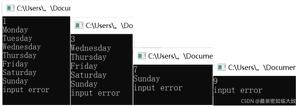在C ++中将按位与的偶数计数为偶数
给我们一个整数数组,任务是计算使用给定数组值可以形成的对的总数,这样对对的AND操作将得出偶数。
AND运算的真值表如下所示
| 一种 | 乙 | A ^ B |
| 0 | 0 | 0 |
| 1 | 0 | 0 |
| 0 | 1 | 0 |
| 1 | 1 | 1 |
输入− int arr [] = {2,5,1,8,9}
输出-按位与为偶数的对数为-7
说明-
| a1 | a2 | a1 ^ a2 |
| 2 | 5 | 0 |
| 2 | 1 | 0 |
| 2 | 8 | 0 |
| 2 | 9 | 0 |
| 5 | 1 | 1 |
| 5 | 8 | 0 |
| 5 | 9 | 1 |
| 1 | 8 | 0 |
| 1 | 9 | 1 |
| 8 | 9 | 8 |
以下程序中使用的方法如下
输入整数元素数组以形成一对
计算数组的大小,将数据传递给函数以进行进一步处理
创建一个临时变量计数以将与AND运算形成的对存储为偶数。
从i到0开始循环直到数组大小
在循环内部,检查IF arr [i]%2 == FALSE,然后将计数加1
将计数设置为count *(count-1)/ 2
创建一个临时变量以存储形成的对的总数,并将其设置为(size *(size-1)/ 2)
存储奇数作为从形成的对总数中减去的计数
返回奇数值
打印结果。
示例
#include <iostream>using namespace std;
//用按位AND作为偶数来计数对
int count_pair(int arr[], int size){
int count = 0;
for (int i = 0; i < size; i++){
if (arr[i] % 2 != 0){
count++;
}
}
count = count * (count - 1) / 2;
int total_pair = (size * (size - 1) / 2);
int odd = total_pair - count;
return odd;
}
int main(){
int arr[] = {2, 5, 1, 8, 3 };
int size = sizeof(arr) / sizeof(arr[0]);
cout<<"Count of pairs with Bitwise-AND as even number are: "<<count_pair(arr, size) << endl;
return 0;
}
输出结果
如果我们运行上面的代码,它将生成以下输出-
Count of pairs with Bitwise-AND as even number are: 7
以上是 在C ++中将按位与的偶数计数为偶数 的全部内容, 来源链接: utcz.com/z/343378.html




